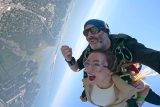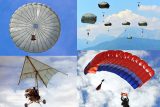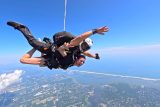Skydiving Positions and Why It’s Important
Skydiving
Posted by: Long Island Skydiving Center
5 years ago
It was not so long ago when people believed that if you stuck your arms and legs out when jumping from an airplane they would be torn off by the sheer force of the wind. This is not true, but there was an accurate basic assumption contained in this thinking – that speed does indeed affect how we skydive. The speed of your body zooming through the air creates force. This force is called the ‘relative wind’ and can be used in different ways to create stability and even movement while in freefall. The best way to experience relative wind on the ground is by sticking your hand out of the window of a car while traveling at a decent speed. You will be able to feel the power of the air pushing against the surfaces at different angles as you wiggle it about.
Arch!

The first orientation you use when learning to skydive is ‘Belly-Flying’ – with your stomach pointing towards the ground and your chin up looking forwards. Creating an arch shape with your body like this is for stability – as being stable in freefall is what you must first achieve before learning how to move around. When you arch your hips are the lowest point – your arms and legs are up high which also adds to stability by creating drag. If you picture this position from the side it should look kind of like a banana.
The best way to imagine how an arch works is to think of a shuttlecock – and how when it travels through the air the feathers want to go slower and the ball part wants to go faster. The drag from the feathers means the ball part always naturally points in the direction of travel. When you arch, your hips are the ball and your limbs are the feathers – so your hips will stay down in the correct orientation – nice and stable. This also comes into play when exiting the pane. When you jump out, a skydiving aircraft travels forward at roughly 100mph – which means that the relative wind is actually coming from in front rather than down. On exit, you actually point your arch forwards into the wind first and then gradually over the first ten seconds your forward speed transitions into downward speed. Just like how a shuttlecock flies – your body does the same.
Preparation
Stretching out before you go jumping is always a good idea. You don’t have to be a super fitness person to be a skydiver, but a decent level of swellbeing is recommended. Fitness can help greatly with body awareness – and this is what skydiving is all about. Getting in and out of the plane can involve a bit of bodily folding, and you might need to run out the odd landing on days where there is no wind to fly into on approach.
You can practice arching by lying with your belly flat on the ground and picking everything else up to create that banana shape. Don’t be perturbed by how this feels like hard work – when your body is supported by the wind this is much more comfortable. On the floor you will feel it in many muscles after just a handful of seconds. In the sky you will probably not even notice. It is worth doing this a bit, and at the dropzone during your ground training your instructors are for sure going to make you until they are happy to move on.
More Skydiving Positions

Once you are learning to skydive it is not long at all before you need to learn some more positions. When you are jumping with others, it is important for everyone to move away into enough space to open your parachute without anyone else close by. The position you use for this is called ‘Tracking’, whereby you basically make your body into a long plank shape that dives forwards by deflecting air backwards. Down the road a bit, when you have got the hang of flat skydiving and some general skill and awareness – you can learn to ‘Freefly’. Freeflying means to use the various surfaces of your body to hold positions and flying at every angle you can think of – such as ‘head-up’ and ‘head-down’.
…
Skydiving is an epic journey that can very much change your life. The quest for greater knowledge and better skills never ends, and this provides huge rewards that remain with you forever. Get involved!
Categories:
You May Be Interested In:

Skydiving After LASIK: What You Need to Know
8 months ago by Long Island Skydiving Center

What Parachute Types Are There?
8 months ago by Long Island Skydiving Center

How Dangerous is Tandem Skydiving?
10 months ago by Long Island Skydiving Center

Nervous About Skydiving? Here Are Our Top 6 Tips!
10 months ago by Long Island Skydiving Center